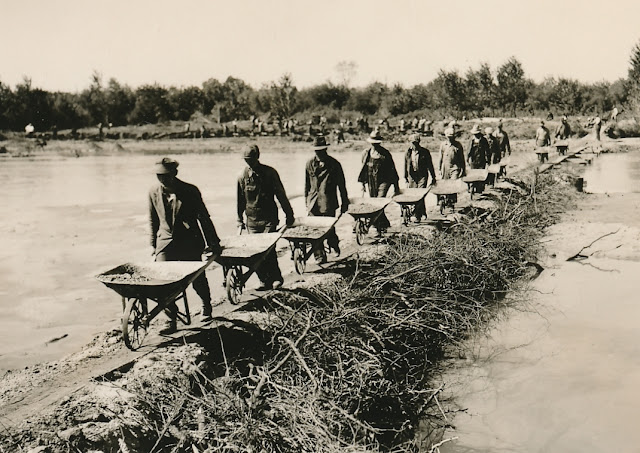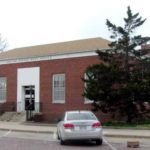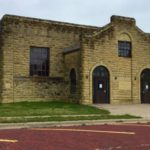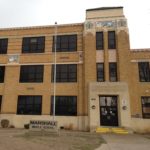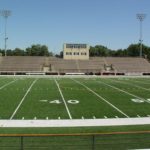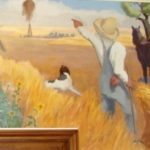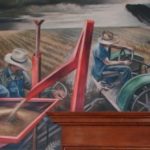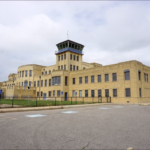As politicians in Washington debate massive new infrastructure spending, it’s interesting to recall how the New Deal programs of nearly a century ago affected Wichita.
The impact of those projects spearheaded by President Franklin Roosevelt can hardly be overstated. They are still a big part of the city’s life in areas ranging from its riverfront and water supply to industry, education, transportation, recreation and the arts. Iconic structures such as the city’s original, Art Deco-style airport terminal — now home of the Kansas Aviation Museum — picturesque Campbell Street bridge and Spanish-style College Hill bathhouse are a few examples.
Less known are projects like the Water Treatment Plant, which upgraded the city’s drinking water.
“We take all this stuff for granted but it’s continued to bless us for nearly a hundred years,” architect Dean Bradley said.
“There’s some cool stuff out there,” agreed Larry Hoetmer, principal planner for the city.
The New Deal was an umbrella term for several different programs — including the Civilian Works Administration, Public Works Administration and Works Progress Administration — started by Roosevelt to try to pull the United States out of the Great Depression. Although the New Deal is primarily associated with federal spending, local and state governments often had to pay portions of the cost.
One of the biggest and earliest New Deal projects here was the removal of Ackerman Island from the Arkansas River. The island, which at one time held Wonderland amusement park, nearly filled the Arkansas River from the Douglas Street bridge to where The Keeper of the Plains stands today. The island contributed to flooding during heavy rains, while the portion of river that flowed west of it became a stagnant pool when water levels were low.
To remove it, workers used shovels and wheelbarrows to move 350,000 pounds of soil from the east side of the island to fill in the west channel, changing the contour of the riverbank. The project cost $1 million. Heavy equipment would have moved the dirt more cheaply, but providing jobs was the point.
Parks and roads
The island had also held the city’s baseball stadium. To replace it, Lawrence-Dumont Stadium was built with New Deal money. It operated from 1935 to its demolition in 2018.
In other places, the city removed sand bars, graded river banks and built sidewalks. The widening of Broadway started in 1933 and ran from the northern city limit to its southern edge, becoming a subsection of U.S. Highway 81 in the process. McLean Boulevard, meanwhile, was realigned to follow the new west river bank and surfaced for the first time north and south of Douglas.
The city had 11 parks at the time, and all benefited in some way from New Deal projects, often in the form of building new or improving existing swimming pools and bathhouses. Among structures still in use today are the community building at McAdams Park, Linwood Park-South greenhouse, Park Villa restroom building in Riverside Park and the College Hill children’s pool and bathhouse. Sim Park golf course was improved and numerous concrete grills and park benches were built nearby that remain.
Other improvements from that era have disappeared, such as the huge pool in South Riverside Park that shows up in many postcards.
Wichita used federal money to remove street car lines and replace them with city busses. Nearly 200 men were employed tearing out the tracks. Thirty new busses arrived in the summer of 1935. Major drainage projects were undertaken at 18th and Garland, on East Kellogg near the Veterans Administration Hospital and at Mt. Carmel Academy. Several bridges built with New Deal help continue carrying traffic today, including the Bitting and Campbell bridges.
Airport and art
Wichita Municipal Airport, then located on the outskirts of town at 31st South and Oliver, benefited from a decade of New Deal spending starting in 1933. Working on the administration building and terminal had been begun by the city in 1929 but halted because of the stock market crash and the ensuing Great Depression. With the federal government supplying 30 percent of the money, the building was completed in 1934.
The next year, federal funds paid for 138 men to spend four months paving runways and building sidewalks at the airport. A diagonal road, George Washington Boulevard, was built to connect the city to the airport. In 1936, almost 200 men were employed in paving, drainage, excavating and landscaping work at the airport.
Considered important to national defense because of its central location and Wichita’s prominence in the aviation industry, the airport received millions more in the early 1940s that was used for runways, tarmac, buildings and maintenance equipment.
Like the airport, the Wichita Art Museum had been envisioned for years but never actually built until the federal government pitched in $23,900 in 1934. At one point, the city had considered locating the museum on the second floor of the stalled airport building. Instead, it was completed at its current location on Museum Boulevard in 1935, designed in the Art Deco style by a New York architect. Although budget constraints forced the city to leave off two planned wings, the new museum was featured in Art Digest magazine and Architecture magazine. The original museum was encased by brick when the museum was completely rebuilt in the 1970s, and few if any of its features can be seen today.
Water works
Beginning in the 1880s, Wichita had obtained its municipal water supply from wells on Waterworks Island, located northwest of Ackerman Island (and eventually attached to the river bank). Dissolved minerals made the water less than desireable for drinking. In 1938, the city started a project to bring soft water from the Equus Beds near Halstead, with the federal government providing nearly half the funds required. A PWA grant also helped pay for the filtration system at the Colonial Revival-style Wichita Water Works building west of the art museum.
Schools and sewing
Wichita’s school district built several schools with help from the federal government, including John Marshall Middle School, Thomas Jefferson Elementary School, Jardine Junior High, Douglas MacArthur Elementary School and Will Rogers Elementary School. All but Marshall were designed to accommodate children of defense workers pouring into south Wichita. Another federal grant turned the upper floor of the Forum, the city’s main auditorium at the time, into a recreational center for defense workers. And in 1942, a federal grant of $360,000 — combined with $525,000 raised by the Sisters of St. Joseph — allowed for construction of St. Joseph Hospital on the city’s south side.
Wichita State University was a major beneficiary of the New Deal. Under its politically connected president, William Jardine, WSU obtained more federal money than any other college in Kansas, using it to double the number buildings on campus. The first federal grant was used to pave campus roads, which were notoriously bumpy (and muddy in wet weather). More money was used to complete Wilner Auditorium in 1936 and Morrison Hall two years later.
Federal money paid for 45 percent of a new university library, built to replace the Carnegie Library that had stood since 1909 (and was stuffed with twice as many books as its size dictated). The federal government covered a similar portion of the Georgian Revival-style President’s Residence, completed in 1939.
One New Deal project at WSU that didn’t go as planned was the football stadium. The shool razed the old stadium, known as Shocker Field, after the 1939 season and announced plans for a new stadium, to be called Shocker Bowl and located at 21st and Hillside. A 1940 federal grant of $52,500 paid for another “wheelbarrow army” to remove dirt from the stadium’s bowl during the first phase of construction. The school got a second WPA grant to erect steel stands to hold seats, but in 1942, the government ordered it to stop construction because steel was needed for the war effort. Construction on what’s now Cessna Stadium resumed in 1946, mostly paid for by private donations. The school recently said it will be torn down.
New Deal work wasn’t all heavy construction. Wichita’s largest single WPA allocation was $643,000 for sewing rooms and supplies — the first was located at 201 N. Waco — which trained unemployed workers and provided finished goods to charities.
Throughout the New Deal era, there was criticism that some projects were “make-work” or “weed cutting.” But generally they were popular, at least judging by Roosevelt’s three successful re-election bids.
Editor’s note: This article relies heavily on “New Deal Construction Projects, Wichita, Kansas, A Decade of Change,” WSU, Dec. 1994 by Jeffrey L. Tully.
